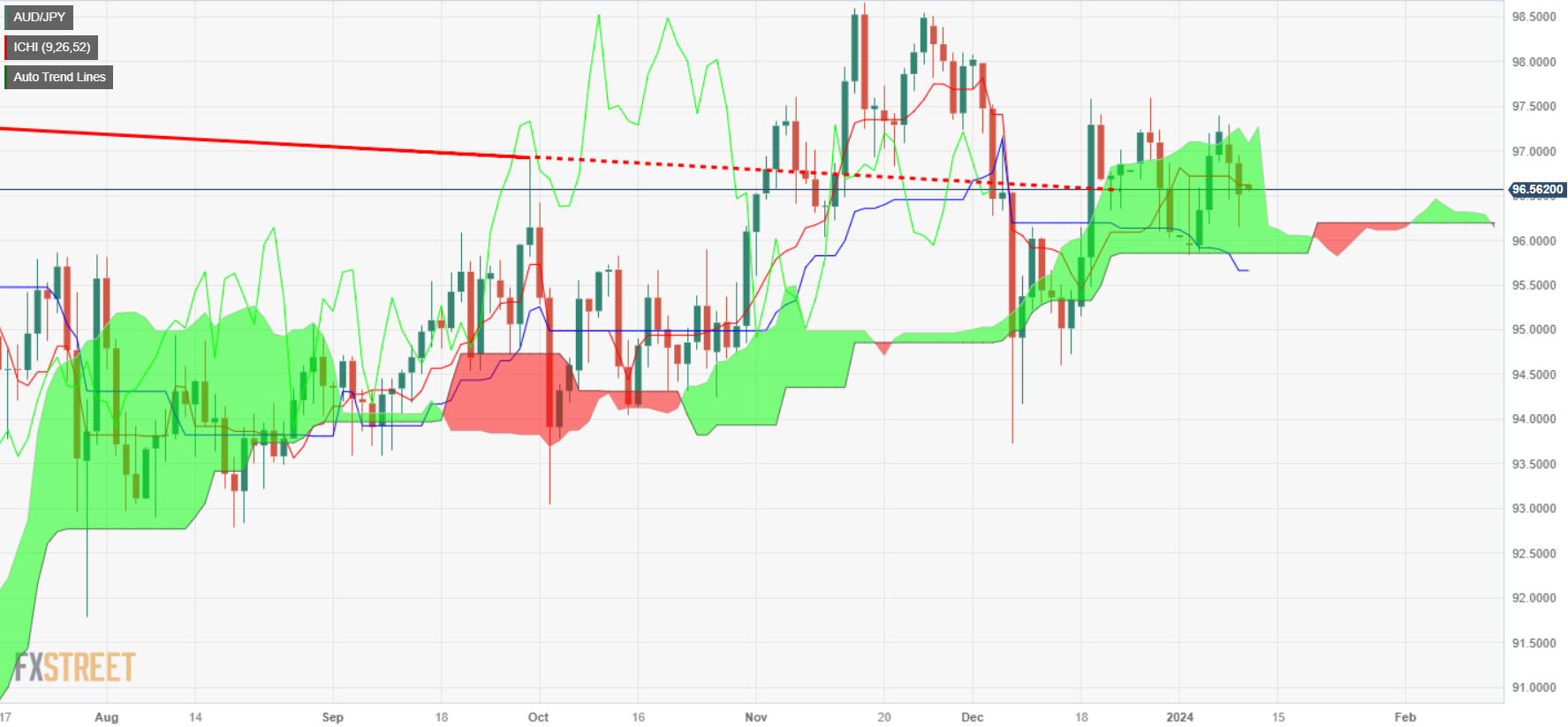- AUD/JPY's continued downtrend reflects risk-off mood and strength in safe-haven currencies, falling 0.32% on Tuesday.
- Market focus on upcoming US inflation data, with implications for Fed's rate path and broader market sentiment.
- Technical analysis suggests neutral bias; key levels to watch include resistance at 97.00 and support at 96.14 and 96.00.
The Aussie Dollar (AUD) extended its losses against the Japanese Yen (JPY) for the second straight day, as risk appetite took a toll, while safe-haven currencies posted decent gains. Therefore, the AUD/JPY lost 0.32% on Tuesday, and as the Wednesday Asian session began, it traded at 96.54, down by 0.04%.
Fundamentally speaking, traders are awaiting the release of the latest inflation report in the United States (US), which will most likely provide clues to Federal Reserve (Fed) officials to lay the path for the year. Meanwhile, two policymakers crossing the wires on Monday suggested the current interest rate level is appropriate, and further easing is expected toward the end of the year.
A higher inflation reading could trigger a repricing of a less dovish Fed by the futures market, hence shifting sentiment sour and boosting safe-haven peers. Otherwise, the AUD/JPY could edge higher.
From a technical standpoint, the AUD/JPY is neutrally biased, though at the brisk of breaking crucial resistance levels at 97.00, followed by the confluence of a downslope resistance trendline and the 97.20 figure. Once cleared, that could open the door to challenging 98.00.
On the flip side, if buyers fail to reclaim 97.00, that could exacerbate a drop toward the bottom of the Ichimoku Cloud (Kumo). But AUD/JPY sellers must reclaim the January 9 low of 96.14, followed by the 96.00 mark, and the bottom of the Kumo at 95.80. Once broken, the Kijun-Sen is up next at 96.54.
AUD/JPY Price Action – Daily Chart
AUD/JPY Technical Levels
Information on these pages contains forward-looking statements that involve risks and uncertainties. Markets and instruments profiled on this page are for informational purposes only and should not in any way come across as a recommendation to buy or sell in these assets. You should do your own thorough research before making any investment decisions. FXStreet does not in any way guarantee that this information is free from mistakes, errors, or material misstatements. It also does not guarantee that this information is of a timely nature. Investing in Open Markets involves a great deal of risk, including the loss of all or a portion of your investment, as well as emotional distress. All risks, losses and costs associated with investing, including total loss of principal, are your responsibility. The views and opinions expressed in this article are those of the authors and do not necessarily reflect the official policy or position of FXStreet nor its advertisers. The author will not be held responsible for information that is found at the end of links posted on this page.
If not otherwise explicitly mentioned in the body of the article, at the time of writing, the author has no position in any stock mentioned in this article and no business relationship with any company mentioned. The author has not received compensation for writing this article, other than from FXStreet.
FXStreet and the author do not provide personalized recommendations. The author makes no representations as to the accuracy, completeness, or suitability of this information. FXStreet and the author will not be liable for any errors, omissions or any losses, injuries or damages arising from this information and its display or use. Errors and omissions excepted.
The author and FXStreet are not registered investment advisors and nothing in this article is intended to be investment advice.
Recommended content
Editors’ Picks

EUR/USD treads water just above 1.0400 post-US data
Another sign of the good health of the US economy came in response to firm flash US Manufacturing and Services PMIs, which in turn reinforced further the already strong performance of the US Dollar, relegating EUR/USD to the 1.0400 neighbourhood on Friday.

GBP/USD remains depressed near 1.2520 on stronger Dollar
Poor results from the UK docket kept the British pound on the back foot on Thursday, hovering around the low-1.2500s in a context of generalized weakness in the risk-linked galaxy vs. another outstanding day in the Greenback.

Gold keeps the bid bias unchanged near $2,700
Persistent safe haven demand continues to prop up the march north in Gold prices so far on Friday, hitting new two-week tops past the key $2,700 mark per troy ounce despite extra strength in the Greenback and mixed US yields.

Geopolitics back on the radar
Rising tensions between Russia and Ukraine caused renewed unease in the markets this week. Putin signed an amendment to Russian nuclear doctrine, which allows Russia to use nuclear weapons for retaliating against strikes carried out with conventional weapons.

Eurozone PMI sounds the alarm about growth once more
The composite PMI dropped from 50 to 48.1, once more stressing growth concerns for the eurozone. Hard data has actually come in better than expected recently – so ahead of the December meeting, the ECB has to figure out whether this is the PMI crying wolf or whether it should take this signal seriously. We think it’s the latter.

Best Forex Brokers with Low Spreads
VERIFIED Low spreads are crucial for reducing trading costs. Explore top Forex brokers offering competitive spreads and high leverage. Compare options for EUR/USD, GBP/USD, USD/JPY, and Gold.
